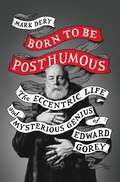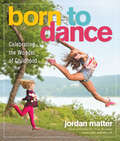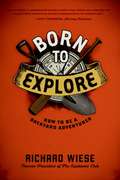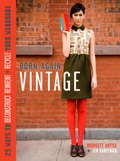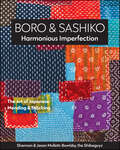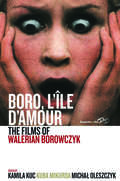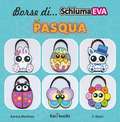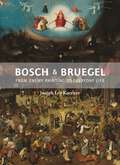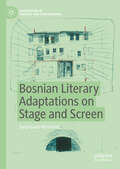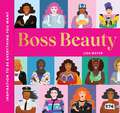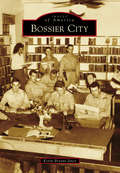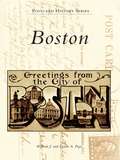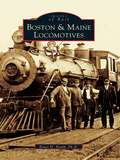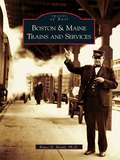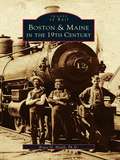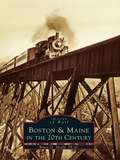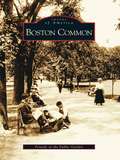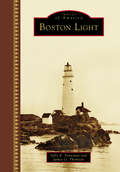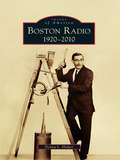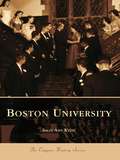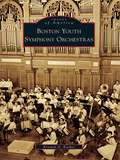- Table View
- List View
Born to Be Posthumous: The Eccentric Life and Mysterious Genius of Edward Gorey
by Mark DeryThe definitive biography of Edward Gorey, the eccentric master of macabre nonsense.From The Gashlycrumb Tinies to The Doubtful Guest, Edward Gorey's wickedly funny and deliciously sinister little books have influenced our culture in innumerable ways, from the works of Tim Burton and Neil Gaiman to Lemony Snicket. Some even call him the Grandfather of Goth.But who was this man, who lived with over twenty thousand books and six cats, who roomed with Frank O'Hara at Harvard, and was known--in the late 1940s, no less--to traipse around in full-length fur coats, clanking bracelets, and an Edwardian beard? An eccentric, a gregarious recluse, an enigmatic auteur of whimsically morbid masterpieces, yes--but who was the real Edward Gorey behind the Oscar Wildean pose?He published over a hundred books and illustrated works by Samuel Beckett, T.S. Eliot, Edward Lear, John Updike, Charles Dickens, Hilaire Belloc, Muriel Spark, Bram Stoker, Gilbert & Sullivan, and others. At the same time, he was a deeply complicated and conflicted individual, a man whose art reflected his obsessions with the disquieting and the darkly hilarious.Based on newly uncovered correspondence and interviews with personalities as diverse as John Ashbery, Donald Hall, Lemony Snicket, Neil Gaiman, and Anna Sui, BORN TO BE POSTHUMOUS draws back the curtain on the eccentric genius and mysterious life of Edward Gorey.
Born to Dance: Celebrating the Wonder of Childhood
by Jordan Matter“In Jordan Matter’s photos, dancers make all the world their stage.” —New York Times From Jordan Matter, YouTube star and New York Times–bestselling author of Dancers Among Us, a celebration of what it means to be young and full of possibility, featuring gorgeous photographs of well-known dancers (including Tate McRae and Sofie Dossi) as well as stars in the making. Jordan Matter is known to millions for his 10 Minute Photo Challenge YouTube videos. Now, in one dazzling photograph after another, he portrays dancers—ages 2 through 18—in ordinary and extraordinary pursuits, from hanging with friends to taking selfies, from leaping for joy to feeling left out. The subjects include TV and internet stars like Chloé Lukasiak, Kalani Hilliker, Nia Sioux, and Kendall Vertes, as well as boys and girls from around the neighborhood. What they all share is the skill to elevate their hopes and dreams with beauty, humor, grace, and surprise. Paired with empowering words from the dancers themselves, the photographs convey each child’s declaration that they were born to dance. Bonus Features: Scan the QR code next to dozens of photos and watch behind-the-scenes videos documenting the shoots. “Breathtaking photos to free your imagination.” —Diane Sawyer, ABC World News “When you take the natural grace of dancers and put them in unexpected places, you get photos that really tell a story.” —Fox News
Born to Draw Comics: The Story of Charles Schulz and the Creation of Peanuts
by Ginger WadsworthBorn to Draw Comics, a mixed-panel format picture book biography of Charles "Sparky" Schulz, creator of the beloved comic strip Peanuts.As a child, Charles split his free time between adventures outdoors with his friends and dog Spike, and daydreams and doodles inspired by the comics he loved to read. He longed to become a professional cartoonist, but saw his dreams deferred by unexpected challenges that laid ahead: military deployment to the European front of World War II, and the heartbreak of a family tragedy back home. Even so, Charles never lost sight of the hopeful joy of his early years and his love for Spike, both of which inspired PEANUTS. The comic strip went on to become the most popular and influential in comics history.For fans of Brad Meltzer’s New York Times-bestselling picture book biography of the Muppets and Sesame Street creator, I Am Jim Henson.Christy Ottaviano Books
Born to Explore
by Richard WieseBorn to Explore is filled with skills, projects, and essential knowledge for the budding adventurer Explorer extraordinaire Richard Wiese's more than one hundred excellent projects show how to have fun with science and nature, how to not always take the most walked path, and how to learn to "read" the natural world. Discovery does not occur just in the Amazon or deep in the ocean. It happens everywhere around us: Navigate by the stars, Tell time without a watch, Start a fire without a match, Make an igloo, Build your own canoe, And be prepared for any challenge.
Born-Again Vintage
by Jen Karetnick Bridgett ArtiseFashion designer Bridgett Artise believes in second chances--a philosophy that extends all the way to her clothing line, B. Artise Originals. Fashion gave her a second chance at happiness and success, and, in turn, she gives vintage garments that have lost their luster another chance at being fashionable. Mixing contemporary clothing with the best elements of a vintage piece--like the collar of a funky fifties housedress or the pockets of a seventies-style jacket--and piecing them back together in a whole new way, she creates one-of-a-kind garments that are both trend setting and timeless. An old-fashioned ruffled shirt with terrific buttons, plus an inexpensive tank top, can become a unique top. A poodle skirt and that so-last-year's knee-length cardigan sweater can be turned into anything from a mini-poncho to a structured tube top. With fashions for every season, Born-Again Vintage contains patterns for:*Pants that pair perfectly with winter boots and a sweater dress that's sexy and simple*A cropped jacket + sweater corset that are perfect for a flirty spring fling*Dresses + bags to keep summer easy and breezy*Pretty-in-a-blink dresses + accessories for a big night outBorn-Again Vintage updates the trends of fashion eras gone by and brings the unparalleled quality of vintage into a new age. Complete with a vintage shopping guide, handy style tips, and ideas for reinventing disused cast-offs, Born-Again Vintage is a must-have for vintage shoppers and sewers alike.
Boro & Sashiko, Harmonious Imperfection: The Art of Japanese Mending & Stitching
by Shannon Mullett-Bowlsby Jason Mullett-BowlsbyFall in love with boro & sashiko stitching 30+ authentic stitch patterns, 9 projects. Combine hand stitches to create dramatic, unique designs and learn to embrace imperfection, admiring the utilitarian beauty of every stitch. “Shibaguyz” Shannon and Jason Mullett-Bowlsby invite you to try your hand at boro, the traditional Japanese art of mending and quilting, and more than 30 authentic sashiko designs. Stitching lessons are true to tradition, inspired by historical works by Japanese masters. This guide in sashiko and boro includes patterns, stitch how-tos, and needle-threading and knotting tips. Put your handwork to good use with 9 contemporary projects like a sashiko sampler wallhanging, reversible knot bag, or a kimono-inspired jacket! With step-by-step instructions, even beginners can embrace the art of visible mending. Hand sew 30+ authentic sashiko patterns with best-selling authors the Shibaguyz Recreate the traditional art of boro (mending textiles) with 9 useful projects from jackets and bags to home decor Read stitch charts, mark fabrics, and thread your needle with tips from the pros
Boro, L'Île d'Amour: The Films of Walerian Borowczyk
by Michał Oleszczyk Kamila Kuc, Kuba MikurdaThere has been a recent revival of interest in the work of Polish film director Walerian Borowczyk, a label-defying auteur and “escape artist” if there ever was one. This collection serves as an introduction and a guide to Borowczyk’s complex and ambiguous body of work, including panoramic views of the director’s output, focused studies of particular movies, and more personal, impressionistic pieces. Taken together, these contributions comprise a wide-ranging survey that is markedly experimental in character, allowing scholars to gain insight into previously unnoticed aspects of Borowczyk’s oeuvre.
Borrowed Time: Photographs by Caroline Vaughan
by Caroline VaughanCaroline Vaughan's photographs offer inspired and surprising visions of landscapes, still lifes, and the human form. In Borrowed Time, her images of nature and people, sometimes surreal and often arresting, follow each other to create a visual poem of opposition and likeness, physical beauty and balance. Compelling the viewer's attention with delicate rich tones and meticulous technique, she holds the viewer's gaze even when her subject is difficult. Most highly acclaimed for her psychologically complex but subtle portraits of family, friends, loved ones, and strangers, Vaughan's work, though widely published and displayed, is collected here for the first time.
Borse di schiuma EVA: Pasqua
by F. Rossi Karina Martinez RamirezCrea borsette incredibili e originali con la schiuma EVA! Il libro Borse di schiuma EVA: Pasqua ti mostrerà passo passo come creare formidabili borsette usando la schiuma EVA (etilene vinil acetato) con diverse forme. Impara la tecnica senza problemi, perché il procedimento viene spiegato passo passo, e potrai fare tante borsette quante vorrai. Questo libro è un alleato eccellente per ogni tipo di situazione: •Potrai creare queste originali borsette per i tuoi amici, la famiglia o i conoscenti. •Potrai aggiungere caramelle o altri piccoli regali per creare regali originali per i compleanni, i matrimoni, la Pasqua, il Natale, Halloween, le prime comunioni, i battesimi o altri eventi. •Potrai divertirti con i tuoi bambini, spiegando loro i passi da fare per creare le borsette. Sarai orgogliosa dei tuoi bambini che riusciranno a finire un progetto così carino e divertente. •Potrai fare delle attività extracurricolari con i tuoi bambini e insegnargli il valore della creatività, della responsabilità e del lavoro artistico. Un libro per divertirsi in famiglia! *** Tutti gli schemi sono inclusi nel libro ***
Bosch and Bruegel: From Enemy Painting to Everyday Life (The A. W. Mellon Lectures in the Fine Arts #57)
by Joseph Leo KoernerA bold new interpretation of two northern Renaissance mastersIn this visually stunning and much anticipated book, acclaimed art historian Joseph Koerner casts the paintings of Hieronymus Bosch and Pieter Bruegel in a completely new light, revealing how the painting of everyday life was born from what seems its polar opposite: the depiction of an enemy hell-bent on destroying us.Supreme virtuoso of the bizarre, diabolic, and outlandish, Bosch embodies the phantasmagorical force of painting, while Bruegel, through his true-to-life landscapes and frank depictions of peasants, is the artistic avatar of the familiar and ordinary. But despite their differences, the works of these two artists are closely intertwined. Bruegel began his career imitating Bosch's fantasies, and it was Bosch who launched almost the whole repertoire of later genre painting. But Bosch depicts everyday life in order to reveal it as an alluring trap set by a metaphysical enemy at war with God, whereas Bruegel shows this enemy to be nothing but a humanly fabricated mask. Attending closely to the visual cunning of these two towering masters, Koerner uncovers art history’s unexplored underside: the image itself as an enemy.An absorbing study of the dark paradoxes of human creativity, Bosch and Bruegel is also a timely account of how hatred can be converted into tolerance through the agency of art. It takes readers through all the major paintings, drawings, and prints of these two unforgettable artists—including Bosch’s notoriously elusive Garden of Earthly Delights, which forms the core of this historical tour de force. Elegantly written and abundantly illustrated, the book is based on Koerner’s A. W. Mellon Lectures in the Fine Arts, a series given annually at the National Gallery of Art, Washington.Published in association with the Center for Advanced Study in the Visual Arts, National Gallery of Art, Washington, DCPlease note: All images in this ebook are presented in black and white and have been reduced in size.
Bosnian Literary Adaptations on Stage and Screen (Adaptation in Theatre and Performance)
by Sanja Garić-KomnenićBosnian Literature on Stage and Screen aims to reconcile theoretical approaches with theatrical and cinematic practices by examining two adaptations based on works by the Bosnian author Meša Selimović. The book is informed by scholarship in film and theatre adaptation theories, and is grounded in a comparative approach that focuses on the interplay of sign systems and codes unique to screen and stage. The book looks closely at two adaptations: a screen adaptation of the novel The Fortress and a stage adaptation of the novel The Island.
Boss Beauty: Inspiration to Be Everything You Want
by Lisa MayerThis book presents a unique pairing of portraits of diverse inspirational women—curated from a coveted collection of digital collectibles—with affirmations, words of wisdom, and real-world advice from the founder of Boss Beauties, along with her mentors and role models, to encourage women & girls to pursue their dreams.&“Lisa Mayer's Boss Beauty, filled with thought-provoking quotes from some of the brightest women starting things, running things, and otherwise making their mark, is great inspiration for women and girls and anyone who loves them." —Lauren Iannotti, Editor In Chief of Real Simple Magazine A richly illustrated guide to inspire & empower the next generation of women & girls to be Boss Beauties—to be fierce, to be fearless, to be confident, to be ready for greatness—and to become anything. With real-world wisdom, kick-ass knowhow, and practical advice from Boss Beauties everywhere (including professional athletes, actors, astrophysicists, CEOs, and more) to: • Harness your inner grit • Make an impact in the world • Learn when to say YES • Not give up • Find your superpower • Be everything you want • Be your own Boss Beauty By seeing, reading, and visualizing what being a Boss Beauty means, learn to nurture core Boss Beauties characteristics—including self-love, courage, clarity, grace, and passion—and find inspiration to take charge and become the CEO of your own life. Armed with this book, Boss Beauties in the works are a force to make/embrace a world where aspirations are real, and a woman can be everything she wants.
Bossier City
by Kevin Bryant JonesBossier City sprung up around cotton fields, railroads, steamboats, and factories as the little town across from Shreveport. Today, the city thrives as the fastest growing in Louisiana. The tight-knit community of citizens who have called Bossier City home for several generations has grown to include an influx of newer transplants and Air Force personnel. "Old Bossier" remains the heart of the city, and its established families and businesses are proud to retain the simple nature of the past. This book remembers days of community and closeness, capturing the era when people built their own houses out of materials they had, walked downtown to a diner or market, and saw the first bomber fly overhead. This collection captures 1920s architecture, hardworking residents, and downtown roots but also celebrates the emergent and progressive nature of Bossier City. Today, the arts are flourishing, the stores are busy, the Barksdale Air Force Base is the jewel of the city, and the strong community identity is continually evolving.
Boston
by Elaine A. Pepe William J. PepeFrom 1901 to 1960, the picture postcard recorded almost every aspect of life in the city of Boston. Through the vintage postcards in Boston, readers will tour the city's Emerald Necklace and green spaces, visit Boston's old waterfront, understand Boston's part in America's Revolutionary War, and see the diversity of the city's many museums, churches, libraries, colleges, and internationally famous hospitals. Postcard images depict the many events that have shaped the historic city of Boston.
Boston & Maine Locomotives (Images of Rail)
by Bruce D. HealdThe Boston & Maine Railroad has long captured the hearts of rail enthusiasts, and its locomotives are models of the majesty, power, and romance of American rail. The Boston & Maine was a railroad dynasty running through Massachusetts, New Hampshire, and Maine, and many still remember hearing the whistle blow as a Boston & Maine locomotive spewing smoke and steam pulled into the station.Boston & Maine Locomotives, the third volume in Arcadia's trio documenting the Boston & Maine Railroad, is a history of the locomotives that powered New England's most dominant line. The Ten Wheelers, the Mastodons, the Pacifics, and the other classes of locomotive are seen here as they pull passengers and freight throughout the Northeast. The Boston & Maine was one of the last railroads in the area to continue naming its locomotives, and those engines, from nineteenth-century steam to twentieth-century diesel, are recorded here. The Portland, the Newburyport, the General Sherman, and more ride New England's rails once again in Boston & Maine Locomotives.
Boston & Maine Trains and Services (Images of Rail)
by Bruce D. HealdThe Boston & Maine Railroad serviced most of New England as a primary mode of transportation during the 19th and 20th centuries. The birth of this railroad spurred the growth and development of industry in New England. This heritage is captured in Boston & Maine Trains and Services, the fourth volume in Arcadia's Images of Rail series to focus on the history of this railroad. The trains and services included in this book are the Pullman passenger cars, work trains with flatcars, boxcars, circus trains, plows, stock, cabooses, as well as the Boston & Maine bus service, trucks, and air service.
Boston & Maine in the 19th Century
by Bruce D. HealdAll the romance of early railroading in northern New England pervades Boston & Maine in the 19th Century. This fascinating journey begins in the 1830s with an 8-mile line that just kept growing. By the end of the century, Boston & Maine was traveling over 2,324 miles of track. This first pictorial history of the Boston & Maine explores the heyday of an enterprising railroad. Using spectacular images, most of which have never before been published, the book takes us along scenic stretches of Massachusetts, New Hampshire, and Maine.
Boston & Maine in the 20th Century
by Bruce D. HealdAs the twentieth century dawned, the Boston & Maine Railroad Company controlled virtually all of the rail lines in New Hampshire, as well as much of the service in Maine and Massachusetts. Ultimately, the company operated more than 2,000 stations in northern New England. The train was the most important mode of travel, and the stations were the center of the community. Boston & Maine in the 20th Century continues the first pictorial history of the railroad company, entitled Boston & Maine in the 19th Century. With more than 200 rare images and historical narrative, the book details the trains and their destinations: the terminals, stations, depots, and whistle stops to which they sped. Times changed, and the railroad was passed by; however, its legacy lives on.
Boston Common (Images of America)
by Friends of the Public GardenThe nation's oldest and most venerated public park, Boston Common has belonged to the people of Boston since 1634. Throughout its history, it has been a centerpiece of civic life; the scene of executions, sermons, protests, and celebrations; and in each century, host to famous visitors from Generals Washington and Lafayette to Rev. Martin Luther King Jr. and Pope John Paul II. In Colonial times, it served as a meeting place, pasture, and military training field. Bostonians in the 19th century added treelined malls and paths and, following the Civil War, monuments and fountains. However, for all its adaptation to modern life, Boston Common remains a green retreat remindful of its storied past.
Boston Light (Images of America)
by Sally R. Snowman James G. ThomsonOn September 14, 1716, Boston Light became the first lighthouse established in Colonial America. With many ships floundering in the treacherous waters of the Massachusetts harbor, there was a great need for navigational aid. At night and during storms, it was difficult to discern the entrance to the main shipping channel of Nantasket Roads, situated between the Brewster islands and the town of Hull. The ledges had become a graveyard for ships, resulting in great loss to human life and cargo--a deterrent to European colonization efforts. Ship captains and merchants petitioned the colonial government for a lighthouse to be erected on Little Brewster Island as a way of safe passage to the inner harbor. Three hundred years later, Boston Light continues to serve its purpose. Today, the lighthouse is protected by an ever-present Coast Guard civilian keeper and a cadre of specially trained Coast Guard Auxiliary volunteer assistant keepers.
Boston Radio: 1920–2010
by Donna L. HalperBoston's radio history begins with pioneering station 1XE/WGI, one of America's first radio stations, and includes the first station to receive a commercial license, WBZ; the first FM radio network, W1XOJ and W1XER; and one of the first news networks, the Yankee News Service. Nationally known bandleaders like Joe Rines and Jacques Renard were first heard on Boston radio, as was one of the first weathercasters, E. B. Rideout. The city has been home to a number of legendary announcers, such as Bob and Ray, Arnie Ginsburg, Dick Summer, Dale Dorman, and Charles Laquidara; talk show giants like Jerry Williams and David Brudnoy; and sports talkers like Eddie Andelman and Glenn Ordway. Many Boston radio personalities, such as Curt Gowdy, "Big Brother" Bob Emery, Don Kent, and Louise Morgan, found fame on television but first established themselves on Boston's airwaves. Since 1920, Boston radio has remained vibrant, proving that live and local stations are as important as ever.
Boston University
by Sally Ann KyddMost universities begin with a plot of land on which to build. This was not the case with Boston University. Founded originally in Newbury, Vermont, in 1839, the school moved to Concord, New Hampshire, in 1847 and finally took root in Boston in 1867. The university developed seven schools and colleges within the first few years, with more to come later. Located in the center of a vibrant city, Boston University has become the fourth largest independent university in the nation. In Boston University, follow the development of the school as it grew and changed over one hundred and sixty years. Through vintage images, learn about the Boston University School of Oratory, where the telephone was invented; the Massachusetts Agricultural College, in the heart of the city; and subterranean passages in some of the earliest buildings. Find out about the ghost that haunted one campus building and why the institution was not named Rich University for one of its founders and most generous donors.
Boston Youth Symphony Orchestras (Images of America)
by Krysten A. KechesIn 1958, under the direction of Prof. Marvin Rabin, the Boston University College of Fine Arts established a youth orchestra for junior and senior high school students from the Greater Boston area. The Boston Youth Symphony Orchestras (BYSO), formerly known as the Greater Boston Youth Symphony Orchestras, has flourished over the past 50 years, expanding beyond the original single orchestra and launching many new artistic initiatives. BYSO members have experienced countless unforgettable moments, including performances at the White House, Carnegie Hall, and renowned concert venues across the world. Today, under the musical leadership of Federico Cortese, the BYSO serves over 400 young musicians from 126 communities throughout New England. The BYSO is one of Boston's most prestigious arts organizations, with a programmatic scope that includes three full symphonic orchestras, a string orchestra, a preparatory wind ensemble, four chamber orchestras, 50 chamber music ensembles, and a nationally recognized string training program for underrepresented youth from inner-city communities. The BYSO has selected images from its extensive archives to exhibit the rich history of this organization.
Boston Youth Symphony Orchestras Revised Edition (Images of America)
by Krysten A. KechesIn 1958, under the founding music director, Prof. Marvin Rabin, the Boston University College of Fine Arts established a youth orchestra for junior and senior high school students from the Greater Boston area. The Boston Youth Symphony Orchestras (BYSO), formerly known as the Greater Boston Youth Symphony Orchestras, has flourished over the past 60 years, impacting the lives of thousands of young musicians. BYSO members have experienced countless unforgettable moments, including performances at the White House, Carnegie Hall, and renowned concert venues across the world. Today, under the musical leadership of Federico Cortese, BYSO serves 500 students from over 120 communities throughout New England. BYSO is one of Boston's most prestigious arts organizations, with a programmatic scope that includes three full symphonic orchestras, two young string training orchestras, six chamber orchestras, a preparatory wind ensemble, a chamber music program, and a nationally recognized outreach program that provides rigorous instrument instruction to students from underrepresented communities. In 2008, BYSO established an opera program that has become an integral part of the season repertoire. BYSO has selected images from its extensive archives to exhibit its rich history.
Boston in Motion (Images of America)
by Anthony M. Sammarco Frank CheneyBoston in Motion, the sequel to Trolleys under the Hub, is an intriguing collection of photographs that captures the history of transportation in and around Boston. Authors Frank Cheney and Anthony M. Sammarco trace the stories from the earliest days of public transport with the Winnissimmet Ferry to the MBTA of today. A city known for its comprehensive public transportation, Boston has hosted every type of transit known to urban America. From the ferry, the horse railway, and the omnibus to the steam railroad and, eventually, the subway and bus systems, Boston has always been at the forefront of transportation advancements. The former "El" (the Boston Elevated Railway), the Old Colony Railroad, the Red Line, and the East Boston Line dramatically changed the face of Boston in the late nineteenth and early twentieth centuries. In Boston in Motion, these advancements are presented and explored in a riveting collection of original photographs.
